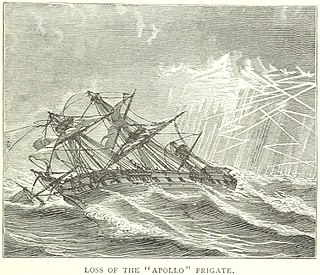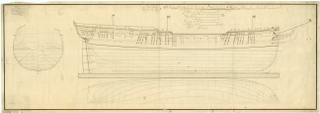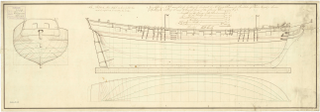Career
Captain Charles Tyler took command of Meleager in 1790.
In 1793 Lieutenant Thomas Masterman Hardy served aboard her. Meleager was among the vessels that shared in the capture, on 5 August 1793, cf the Prince Royal of Sweden. [3]
Meleager was part of the fleet under Lord Hood that occupied Toulon in August 1793. With HMS Courageux, Robust, Tartar and Egmont, she covered the landing, on 27 August, of 1500 troops sent to remove the republicans occupying the forts guarding the port. [4] [5] Once the forts were secure, the remainder of Hood's fleet, accompanied by 17 Spanish ships-of-the-line that had just arrived, sailed into the harbour. [6]
On 16 November she and Romulus captured the French gunboat Ca Ira. [7]
In 1794 Sir George Cockburn commanded her. In early 1794 she was among the British vessels present when Sir David Dundas captured the town of San Fiorenzo (San Fiurenzu) in the Gulf of St. Florent in Corsica. There the British found the French frigate Minerve on 19 February 1794, and were able to refloat her. They then took her into service as a 38-gun frigate under the name St Fiorenzo. Meleager shared in the prize money for both St Fiorenzo and for the naval stores captured in the town. [8]
In April Juno captured the Mars (3 April) and Aurora (15 April) in the presence of Courageux, Berwick, St George, and Meleager. [9]
Next, she took part in the Battle of Genoa (14 March 1795), [10] and the fight at Hyeres (12 May 1795). Meleager was among the vessels that shared in the prize money for the Ça Ira, Censeur, and Expedition (formerly Speedy), captured during or after the raid on Genoa. [11] The British returned Speedy to service. Around this time Meleager was among the vessels that shared in the capture of the Genoese vessel Fortuna and the tartane Concezione. [12] They also captured the Genoese and Venetian polacres and luggers Madona del Grazzie e Consolazione, Volante de Dio, Madona del Grazzie de Padua, Buena Forte and another small vessel. [12]
In 1796, Meleager was part of a squadron off the coast of Genoa under the command of Captain Horatio Nelson. Nelson, in Agamemnon, led Meleager, Blanche (32 guns), Diadem (64 guns) and the 16-gun brig-sloop Speedy.
On 31 May 1796, the squadron chased six French vessels that Nelson believed were bringing supplies from Toulon, to be landed at St. Piere d'Acena, for the Siege of Mantua. [13] The vessels took shelter under the guns of a battery. Meleager then led Agamemnon and the rest of the Nelson's squadron in close where the boats of the squadron could capture the French vessels, which they did. In the action, Agamemnon had one man killed and two men wounded, and Blanche had one man wounded. [13] The French prizes consisted of two warships and five transports:
- ketch Genie of three 18-pounders, four swivel guns and 60 men;
- gunboat Numero Douzel of one 18-pounder, four swivels and 30 men;
- brig Bonne-Mere of 250 tons burthen, transporting brass 24-pounder guns, 13" mortars and gun-carriages;
- ketch Verge de Consolation of 120 tons, transporting brass guns, mortars, shells and gun-carriages;
- ketch Jean Baptiste of 100 tons, carrying brandy and some bread;
- ketch of unknown name of 100 tons, carrying Austrian prisoners; and
- ketch St. Anne de Paix, of 70 tons, transporting wheelbarrows and entrenching tools. The British destroyed the vessel. [13]
On 24 December 1796, Meleager, Niger, Lively and Fortune captured the Spanish vessel Mejor Amigo. [14] On 2 January 1797, the same vessels plus Raven captured Nostra Senora de la Misericordia. [15] That same day the same vessels captured the French privateer Foudroyant, for which head money was paid in August 1801. [16]
Also in early 1797, Meleager was in company with these British vessels and some others when they captured the Spanish ship San Francisco, which was sold in Lisbon. [17] On 30 January Meleager was among the eleven vessels that shared in the capture of the Purissima Conception. [18]
Then on 25 February, Meleager, under Captain Charles Ogle, and Thalia captured the Spanish ship Santa Catalina. [19] At some point Meleager captured the Spanish ships St. Natalia and Cartada, alias Cubana. [20] In May 1798, Meleager received the net proceeds of an insurance of £3000 on the Spanish ship Teresa, which she had captured on 21 February 1797. [21]
Meleager transferred to the Jamaica station, where she served in the squadron under Admiral Sir Hyde Parker. In June 1799 she captured a Spanish settee carrying sugar from Vera Cruz to Cadiz. [22] On 23 and 24 July Meleager was in company with Greyhound when they captured the Spanish vessels Virgin D'Regla, Jesus Maria, and Jose. [23]
Between end-July and end-October 1799 Meleager and Greyhound captured five more Spanish vessels: [24]
- ship Santa Anna, of 12 guns, 24 men, 320 tons, sailing from Havana to Vera Cruz with a cargo of wine, wax, tar and the like;
- cutter Vecourso, of two guns, 12 men and 50 tons, sailing from Nantz to Vera Cruz with a cargo of steel, bale goods and the like.
- brig Animas sailing from Havana to Vera Cruz with a cargo of brandy, bales, etc.
- schooner Saint Juan Baptiste sailing from Cadiz to Vera Cruz with a cargo of wine and cloth.
- settee Saint Miguel y la Virgin de Regla sailing from Cadiz to Vera Cruz with a cargo of paper, oil, etc.
Alone, Meleager also captured a Dutch schooner sailing from Jaquemel to Curacoa with a cargo of coffee.
Between end-October 1799 and 20 February 1800, Meleager took a number of prizes: [25]
- Dutch schooner Minette of ten men and 40 tons, sailing with coffee from Jaquemel to Curacoa;
- Danish schooner Hazard, of 12 men and 40 tons, sailing from Aux Cayes to St Thomas with coffee; and
- French schooner Virgin, of 30 tons, sailing from Aux Cayes to St Thomas with coffee and rum.
Meleager destroyed a number of the quite small vessels sailing from Aux Cayes to St Thomas:
- French schooner of ten tons with rum;
- French boat with rum;
- French sloop with rum;
- French schooner with coffee; and
- Spanish schooner, of 40 tons, sailing in ballast.
Then she took as prizes:
- Spanish schooner, of 50 tons, sailing in ballast; and
- Spanish Schooner Aimable Marie, of 22 men, 110 tons, sailing from Cadiz to Vera Cruz with bale goods.
Together with Crescent she captured:
- Spanish vessel St. Francisco, sailing from Cuba to St. Martha with bale goods;
- Spanish vessel Nostra Senora de los Dolores, sailing from Porto Bello to Carthagena with tobacco and copper; and
- Spanish vessel Nostra Senora del Carmen, sailing from St. Domingo to Carthagena with naval stores.
Between 28 February and 20 May, Meleager captured two small vessels: [26]
- Spanish xebec Pacaro; and
- Spanish brig Maiste, sailing from Vera Cruz with copper, hides, and soap.
Between 20 May and 3 August 1800, Meleager captured further vessels. First, she detained the American ship Gadson, which was sailing from Porto Cavello to Charleston with indigo, coffee, and tobacco. Then with Crescent and Nimrod she took a Spanish felucca sailing from Havana to Vera Cruz and a Spanish xebec sailing from Campeachy to Havana. [27]
Next, Meleager took four more vessels: [27]
- American ship Diana, sailing from Vera Cruz to New York, with cochineal and sugar;
- English schooner Flora, sailing from Vera Cruz with specie;
- Spanish schooner Bella Johannah, sailing from Campeachy to Porto Cavello with Mahogany;
- American brig Leopard, sailing from Boston to Havana with iron.
Captain John Perkins was made post-captain in Meleager in 1800 on the Jamaica station but less than a year later, in 1801, she came under the command of Thomas Bladen Capel.

HMS Indefatigable was one of the Ardent-class 64-gun third-rate ships-of-the-line designed by Sir Thomas Slade in 1761 for the Royal Navy. She was built as a ship-of-the-line, but most of her active service took place after her conversion to a 44-gun razee frigate. She had a long career under several distinguished commanders, serving throughout the French Revolutionary Wars and the Napoleonic Wars. She took some 27 prizes, alone or in company, and the Admiralty authorised the issue of four clasps to the Naval General Service Medal in 1847 to any surviving members of her crews from the respective actions. She was broken up in 1816.
HMS York was a 64-gun third rate ship of the line of the Royal Navy, launched on 24 March 1796. She served briefly in the West Indies where she captured numerous small vessels. She was wrecked in 1804.

HMS Babet was a 20-gun sixth-rate post ship of the British Royal Navy. She had previously been a corvette of the French Navy under the name Babet, until her capture in 1794, during the French Revolutionary Wars. She served with the British, capturing several privateers and other vessels, and was at the Battle of Groix. She disappeared in the Caribbean in 1800, presumably having foundered.

HMS Apollo, the fourth ship of the Royal Navy to be named for the Greek god Apollo, was a fifth-rate frigate of a nominal 36 guns. She was the name ship of the Apollo-class frigates. Apollo was launched in 1799, and wrecked with heavy loss of life in 1804.
Mutine was an 18-gun Belliqueuse-class gun-brig of the French Navy, built to a design by Pierre-Alexandre-Laurent Forfait, and launched in 1794 at Honfleur. She took part in the Battle of Santa Cruz de Tenerife, where the British captured her. She was recommissioned in the Royal Navy as HMS Mutine, and eventually sold in 1803.

Pomone was a 40-gun frigate of the French Navy, launched in 1785. The British captured her off the Île de Batz in April 1794 and incorporated her into the Royal Navy. Pomone subsequently had a relatively brief but active career in the British Navy off the Atlantic and Mediterranean coasts of France before suffering sufficient damage from hitting a rock to warrant being taken out of service and then broken up in 1803.

HMS Acasta was a 40-gun Royal Navy fifth-rate frigate. She saw service in the French Revolutionary and Napoleonic Wars, as well as the War of 1812. Although she never took part in any notable single-ship actions nor saw action in a major battle though she was at the Battle of San Domingo, she captured numerous prizes and rid the seas of many Spanish, French and American privateers. She was finally broken up in 1821.

HMS Cerberus was a 32-gun fifth-rate frigate of the Royal Navy. She served in the French Revolutionary and the Napoleonic Wars in the Channel, the Mediterranean, the Adriatic, and even briefly in the Baltic against the Russians. She participated in one boat action that won for her crew a clasp to the Naval General Service Medal (NGSM). She also captured many privateers and merchant vessels. Her biggest battle was the Battle of Lissa, which won for her crew another clasp to the NGSM. She was sold in 1814.

HMS Mermaid was a 32-gun Active-class fifth-rate frigate of the Royal Navy, launched in 1784 and broken up in 1815. During the French Revolutionary Wars she served in the West Indies, the Channel, and the Mediterranean. During the Napoleonic Wars she first served in the Americas, but from early 1811 on, she was armed en flute and served as a troopship until she was broken up.

HMS Lowestoffe was a 32-gun fifth-rate frigate of the Royal Navy. Built during the latter part of the Seven Years' War, she went on to see action in the American War of Independence and the French Revolutionary War, and served often in the Caribbean. A young Horatio Nelson served aboard her shortly after passing his lieutenant's examination.

HMS Lark was a 16-gun ship sloop of the Cormorant class, launched in 1794 at Northfleet. She served primarily in the Caribbean, where she took a number of prizes, some after quite intensive action. Lark foundered off San Domingo in August 1809, with the loss of her captain and almost all her crew.

HMS Hornet was a 16-gun ship-rigged sloop of the Cormorant class in the Royal Navy, ordered 18 February 1793, built by Marmaduke Stalkart and launched 3 February 1794 at Rotherhithe. Hornet saw most of her active duty during the French Revolutionary Wars. During the Napoleonic Wars she served for about six years as a hospital ship before being laid up in 1811 and sold in 1817.

HMS Camilla was a Royal Navy 20-gun Sphinx-class post ship. Camilla was built in Chatham Dockyard to a design by John Williams and was launched in 1776. She served in the American Revolution, the French Revolutionary Wars, and the Napoleonic Wars, before being sold in 1831.

HMS Circe was a 28-gun Enterprise-class sixth-rate frigate of the Royal Navy. She was launched in 1785 but not completed or commissioned until 1790. She then served in the English Channel on the blockade of French ports before she was wrecked in 1803.

HMS Merlin was one of the two original Merlin-class sloops that served the Royal Navy during the French Revolutionary Wars. She was launched in 1796 and was broken up in 1803. Her greatest accomplishment was her role as the leading vessel in a motley flotilla of local vessels that defeated a Spanish attack on the British colonists in Honduras at the Battle of St. George's Caye. She later captured a number of small merchant vessels in the West Indies before returning to Britain, where she was broken up.

HMS Clyde was a Royal Navy Artois-class frigate built at Chatham Dockyard of fir, and launched in 1796. In 1797, she was one of only two ships whose captains were able to maintain some control over their vessels during the Nore mutiny. In 1805, HMS Clyde was dismantled and rebuilt at Woolwich Dockyard; she was relaunched on 23 February 1806. She was ultimately sold in August 1814.

HMS Diligence was the name ship of her class of brig-sloops of the Royal Navy. She was launched in 1795 and lost in 1800. She spent her brief career on the Jamaica station where she captured four armed vessels, one of them after a short engagement, and many small Spanish and French merchant vessels in the Caribbean inter-island and coastal trade.
The French corvette Robuste was a vessel built at Nantes in 1789 as a slaver that made her first and only slave-trading voyage in 1789-90. The French navy purchased her in December 1793 and she served as a 22-gun corvette in the Channel. The British captured her in 1796 and took her into the Royal Navy as HMS Scourge. She captured a number of French privateers, primarily in the West Indies, before the navy sold her in 1802.

HMS Echo, launched in 1797 at Dover, was a sloop-of-war in the Royal Navy. She served on the Jamaica station between 1799 and 1806, and there captured a small number of privateers. The Navy sold her in 1809 and she became a whaler. She made four complete whale-hunting voyages but was wrecked in the Coral Sea in April 1820 during her fifth whaling voyage.

HMS Swallow was an 18-gun Albatross-class brig-sloop of the British Royal Navy, launched in 1795 and sold in 1802. During her naval career she captured a number of French privateers while on the Jamaica station. After her sale she became an armed whaler sailing under a letter of marque. As a privateer she captured two French whaling vessels but then is no longer listed after 1810.















